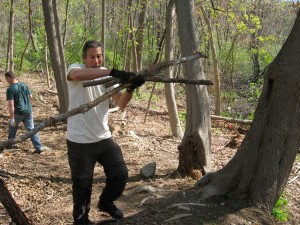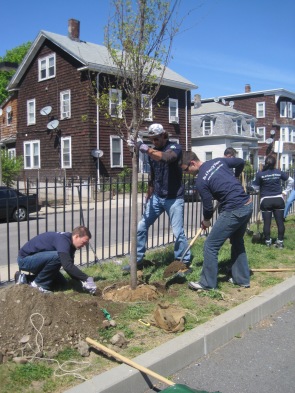This past Saturday was a day of celebration for many in Boston. An estimated 2 million made the trek to downtown Boston for a day of revelry honoring the Red Sox 2013 championship win. 15 miles north of Boston, a special group of 11 volunteers from the BBA’s New Lawyers and Environmental Law Section were involved their own celebration of “youth, food , and community” at The Food Project (TFP) in Greater Lynn. Longtime readers will have heard of The Food Project before, but if you haven’t, TSL has you covered.
The Food Project works with over 150 teenagers and thousands of volunteers to farm on 40 acres of land in different locations across Eastern Massachusetts. Food from the farms is distributed through community agriculture programs, farmers markets and local hunger relief organizations. TFP also offers and educational element and training and services, so youth and volunteers can learn more about farming, healthy eating and sustainable processes.
 Based on that description, it’s pretty clear why our lawyers decided to volunteer at the Food Project again. We reached out to one of Saturday’s volunteers Phelps Turner, of Sugarman, Rogers, Barshak & Cohen (who boasts a renown environmental law practice) to get a sense of his experience volunteering.
Based on that description, it’s pretty clear why our lawyers decided to volunteer at the Food Project again. We reached out to one of Saturday’s volunteers Phelps Turner, of Sugarman, Rogers, Barshak & Cohen (who boasts a renown environmental law practice) to get a sense of his experience volunteering.
1) Why did you decide to volunteer for the food project serve and grow program?
I jumped at this opportunity to volunteer with the Food Project’s Serve and Grow program because I’m very interested in urban agriculture as a means to increasing urban residents’ access to healthy, energy-efficient and affordable food. I was also excited to volunteer because I’m inspired by the Food Project’s mission of bringing urban and suburban youth and adults together to work on farms, to learn about the food we eat and to build a sustainable food system.
2) What did you enjoy most about the experience?
We had beautiful weather for our morning of farming. I especially enjoyed transporting compost that had been produced on the farm and using it to create planting beds, in which we planted garlic for next season. I also enjoyed meeting and working with the local youth, who have developed excellent leadership skills, and seeing old friends and new faces among the BBA volunteers.
3) Did you learn anything new or interesting?
This is my third time volunteering with the Food Project, and I learn new things about the Food Project and the food system every time. This time, I learned, among other things, that 25% of young adults are too obese to qualify for military service, and that the average fast food meal consists of over 1,600 calories, compared to 500 in the average homemade meal. Facts like these underline the importance of increasing access to healthy and affordable food in heavily populated urban settings, which can be achieved in part by growing the food locally, at farms like the one in Lynn.
Thanks, Phelps – we couldn’t have said it better ourselves. Kudos to the 11 who spent their Saturday morning making an impact on the local community… and on parade day, no less.














